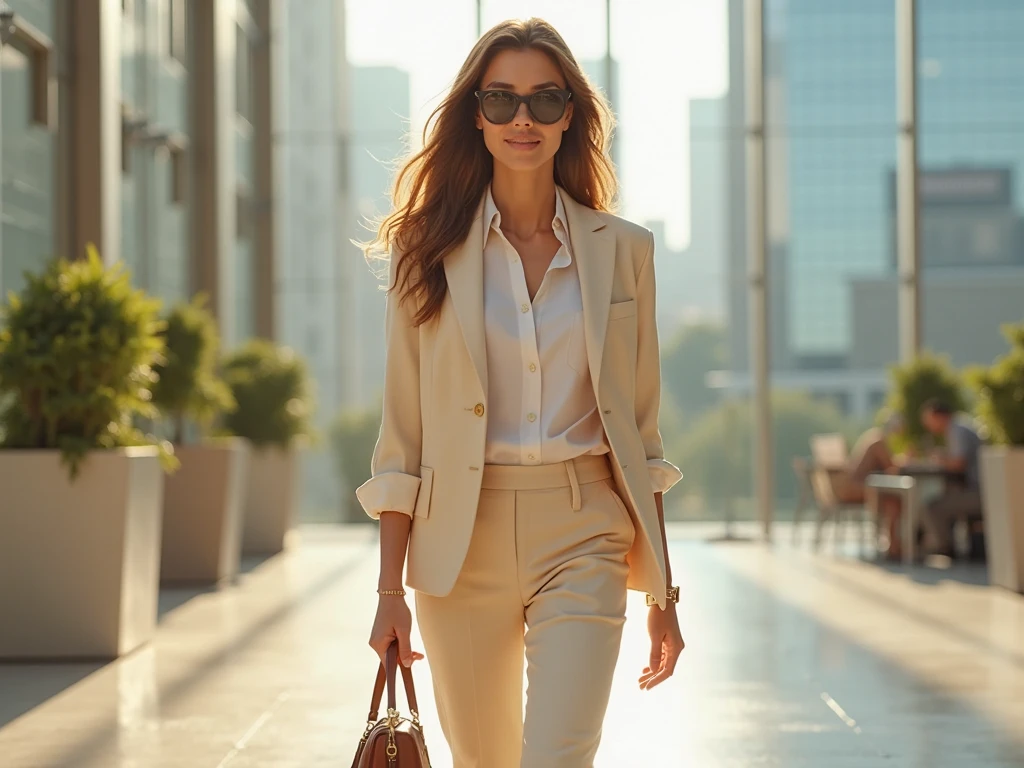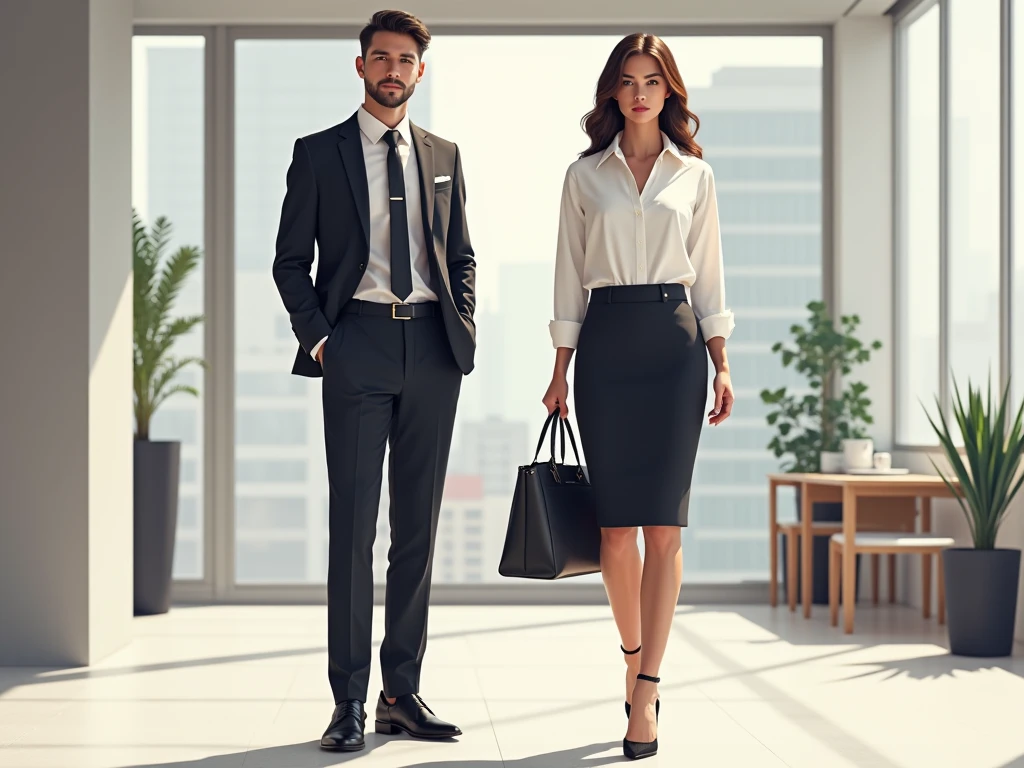
Smart Casual vs Business Casual: Winning the Style Battle with Confidence
Smart casual vs business casual—two dress codes that sound similar but have key differences. If you’ve ever stood in front of your closet unsure which look to choose, you’re not alone. This guide breaks down everything you need to know, so you can dress with confidence for any occasion.
| Category | Business Casual | Smart Casual |
|---|---|---|
| Top | Plain darker color jacket, white or blue plain shirt, no T-shirts | Bright or light color jacket, smart pullover, colorful shirts, plain colored T-shirts (not printed) |
| Pants | Dark jeans, smart chinos in muted colors, no shorts, no ripped jeans | Dark or light jeans, smart chinos (can be light colored in summer), no shorts, no ripped jeans |
| Shoes | Dark leather shoes (brown or black), leather shoes, smart suede shoes, no trainers | Leather shoes, smart suede shoes, no trainers |
| Accessories | Minimal accessories, leather belt (black or dark brown), light or pale blue pocket square, smart watch, smart sunglasses | A few accessories allowed, any belt (even contrasting), colorful pocket squares, discreet wristbands, sunglasses |
| Occasions | Casual Fridays at work, date nights, meetings outside office | Semi-formal events, parties, date nights, informal gatherings |
| Color Palette | Muted colors, darker shades, no patterns | Brighter color combinations allowed, checked shirts or jackets acceptable, no more than three colors |
What Is Business Casual?
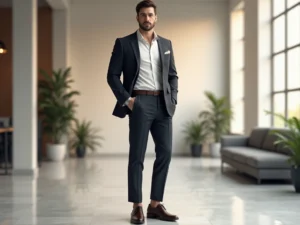
Business casual is a dress code that balances professionalism with comfort, sitting between formal business wear and casual attire. When dressing in smart casual vs business casual, the key difference is that business casual maintains a more polished, office-appropriate look while allowing some flexibility.
For men, this typically means tailored chinos or dark jeans paired with a collared shirt and a blazer or sweater. Women might opt for a blouse with dress pants, a skirt, or a conservative dress. The colors tend to be neutral—navy, gray, black, or muted tones—with minimal patterns. Footwear should be clean and professional, such as loafers, oxfords, or sleek flats.
The goal of business casual is to look put-together without being overly formal. It’s ideal for workplaces that don’t require suits but still expect a professional appearance, such as creative agencies, tech companies, or casual Fridays in corporate settings.
When comparing smart casual vs business casual, remember that business casual leans more toward the professional side, while smart casual allows for more personality and relaxed elements. Avoid overly casual pieces like sneakers, graphic tees, or distressed denim in business casual settings.
Key Elements of Business Casual
- Tops:
- Plain dress shirts (white, light blue)
- Dark blazers or jackets (navy, charcoal, dark brown)
- No graphic tees or loud patterns
- Bottoms:
- Dark jeans or tailored chinos
- No ripped or distressed denim
- Shoes:
- Leather dress shoes (oxfords, loafers)
- No sneakers or sandals
- Accessories:
- Minimalist watch, leather belt
- Avoid flashy jewelry
What Is Smart Casual?
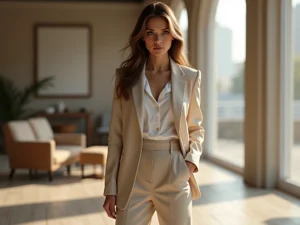
Smart casual represents the perfect middle ground between formal business attire and relaxed everyday wear. When considering smart casual vs business casual, smart casual offers more flexibility while still maintaining a polished appearance. This dress code allows you to express personal style while looking appropriate for semi-formal occasions.
For men, smart casual might include well-fitted jeans or chinos paired with a button-down shirt or a quality knit sweater. A blazer can be added for a more refined look, while clean sneakers or leather shoes complete the outfit. Women can opt for tailored pants, a stylish blouse, or a casual dress paired with elegant flats or ankle boots.
Unlike business casual, smart casual embraces more color and texture variations. You might incorporate subtle patterns, lighter fabrics, or tasteful accessories to elevate your look. However, it’s important to avoid overly casual items like graphic tees, flip-flops, or ripped jeans when aiming for a true smart casual aesthetic.
The smart casual vs business casual distinction becomes clear in their appropriate settings. While business casual suits professional environments, smart casual works best for social gatherings, date nights, or creative workplaces with relaxed dress codes.
Key Elements of Smart Casual
- Tops:
- Button-down shirts (can be patterned or colorful)
- Knit sweaters or smart pullovers
- Plain, well-fitted T-shirts (no logos)
- Bottoms:
- Light or dark jeans (no rips)
- Chinos in neutral or pastel tones
- Shoes:
- Leather or suede shoes (derbies, Chelsea boots)
- Clean, minimalist sneakers (in some cases)
- Accessories:
- Pocket squares, stylish sunglasses
- Layered bracelets or a smartwatch
Smart Casual vs Business Casual: The Key Differences
| Feature | Business Casual | Smart Casual |
|---|---|---|
| Formality Level | Professional but relaxed | Stylish yet approachable |
| Tops | Collared shirts, blouses, muted colors | Button-downs, polos, subtle patterns |
| Bottoms | Dress pants, dark jeans, pencil skirts | Chinos, clean jeans, tailored trousers |
| Footwear | Loafers, oxfords, modest heels | Leather shoes, clean sneakers, boots |
| Outerwear | Structured blazers, cardigans | Unstructured jackets, stylish layers |
| Accessories | Minimal (watch, simple jewelry) | Expressive (pocket squares, scarves) |
| Colors | Neutral tones (navy, gray, black) | Wider palette (pastels, earth tones) |
| Occasions | Office settings, client meetings | Social events, dinners, creative spaces |
When to Wear Business Casual vs Smart Casual?
Understanding when to wear business casual vs smart casual helps you dress appropriately for every occasion. Here’s a simple guide to help you decide:
Best Times for Business Casual
Business casual works best in professional settings where you need to look polished but not overly formal:
- Work Environments:
- Office jobs (especially on casual Fridays)
- Business meetings with clients
- Professional networking events
- Work-Related Social Events:
- Company lunches or dinners
- Conferences or seminars
- Office parties (unless specified otherwise)
Best Times for Smart Casual
Smart casual is ideal for social or semi-formal occasions where you want to look stylish but not too corporate:
- Social Gatherings:
- Date nights or dinners out
- Weekend brunches with friends
- Casual weddings or cocktail parties
- Creative Workplaces:
- Startups or relaxed office cultures
- Creative industry events (art galleries, design meetings)
Color Palette Rules for Smart Casual and Business Casual
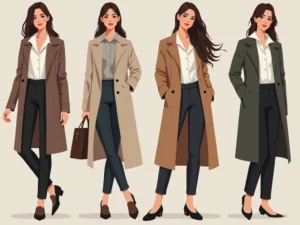
Choosing the right colors is essential when navigating smart casual vs business casual dress codes. The right palette ensures you look appropriate while expressing your personal style.
Business Casual Color Rules
Business casual requires a more restrained, professional approach to color:
- Neutral Foundation:
- Stick to navy, gray, black, and charcoal as base colors
- These work for pants, blazers, and skirts
- Shirt/Blouse Colors:
- White and light blue are universally safe
- Soft pastels (like pale pink or mint) are acceptable in creative offices
- Color Combinations:
- Pair dark bottoms with lighter tops
- Avoid pairing two bright colors together
- Limit patterns to subtle stripes or small checks
- Avoid:
- Neon or overly bright colors
- Large, bold patterns that distract
Smart Casual Color Freedom
Smart casual allows more flexibility while maintaining sophistication:
- Expanded Neutrals:
- Earth tones (khaki, olive, tan) work well
- Light gray and denim blue are versatile
- Color Accents:
- Brighter shirts or sweaters in moderation
- Deep jewel tones (burgundy, emerald) for fall/winter
- Soft pastels for spring/summer
- Pattern Play:
- Small checks or micro-patterns add interest
- Stripes are always classic
- Floral prints (when tasteful) for women
- Color Coordination:
- Use the “three-color max” rule for balance
- Anchor bright pieces with neutrals
Seasonal Considerations for Both Styles
- Summer:
- Business casual: Lightweight fabrics in light neutrals
- Smart casual: Linen in beige or white, pastel shirts
- Winter:
- Business casual: Dark wools and tweeds
- Smart casual: Rich textures in deeper tones
Key Differences in Smart Casual vs Business Casual Colors
| Aspect | Business Casual | Smart Casual |
|---|---|---|
| Base Colors | Strict neutrals | Expanded neutrals |
| Accent Colors | Limited, muted | More vibrant options |
| Patterns | Very subtle | Moderate, tasteful |
| Combinations | Conservative pairings | More creative mixing |
When choosing between smart casual vs business casual, remember: business casual colors should blend in, while smart casual colors can help you stand out (in a good way). Always consider your environment – when in doubt, observe what others are wearing or ask about expectations.
Perfect Occasions for Smart Casual vs Business Casual

Understanding when to wear each dress code helps you always make the right style choice. Here’s your guide to nailing smart casual vs business casual for every event.
When Business Casual Works Best
Business casual shines in professional environments that value polish without formality:
- Work Settings
- Typical office days (especially casual Fridays)
- Client meetings outside the office
- Job interviews at modern companies
- Professional Events
- Business conferences and seminars
- Networking mixers and alumni events
- Corporate training sessions
- Work-Related Socializing
- Office holiday parties
- Team lunches or after-work drinks
- Company picnics (unless specified otherwise)
Remember: Business casual keeps you looking competent and approachable in professional circles.
When Smart Casual Fits Perfectly
Smart casual excels in social situations where style matters but suits feel excessive:
- Social Gatherings
- Date nights at nice restaurants
- Weekend brunches with friends
- Gallery openings or cultural events
- Special Occasions
- Casual weddings or rehearsal dinners
- Cocktail parties without strict dress codes
- Anniversary celebrations
- Creative Work Environments
- Tech startups or design studios
- Creative agency presentations
- Media or advertising industry events
Remember: Smart casual lets your personality shine while maintaining sophistication.
Situations Where Either Works
Some occasions allow flexibility between smart casual vs business casual:
- Informal business dinners
- Weekend professional networking
- Some religious services
- Parent-teacher conferences
Pro Tip: When uncertain, dress slightly more formal and observe what others wear.
Places to Avoid These Dress Codes
- Not Business Casual
- Black tie events
- Court appearances
- Formal award ceremonies
- Not Smart Casual
- Construction sites
- Gym or athletic activities
- Beach outings
By mastering these guidelines for smart casual vs business casual, you’ll always arrive appropriately dressed and confident. The key is matching your outfit to both the event’s formality and your personal comfort level.
Common Mistakes to Avoid in Smart Casual vs Business Casual
When navigating smart casual vs business casual, even small mistakes can make your outfit look out of place. Here are key pitfalls to watch for and how to avoid them:
Mixing Dress Codes Incorrectly
- Problem: Combining formal business pieces with overly casual items creates a confused look
- Examples:
- Pairing a suit jacket with ripped jeans
- Wearing sneakers with dress pants in strict offices
- Fix: Stick to one cohesive style level
Getting the Formality Wrong
- Too Casual for Business:
- Wearing t-shirts or polo shirts in conservative offices
- Choosing sneakers when leather shoes are expected
- Too Formal for Smart Casual:
- Wearing full suits to casual social events
- Over-accessorizing with formal ties and pocket squares
Ignoring Fit and Condition
- Poor Fit:
- Baggy dress shirts or overly tight trousers
- Jackets with sleeves that are too long/short
- Worn-Out Items:
- Faded or wrinkled clothing
- Scuffed shoes that ruin a polished look
Color and Pattern Mismatches
- Business Casual Errors:
- Wearing loud, distracting patterns in professional settings
- Mixing too many bright colors
- Smart Casual Missteps:
- Going overly neutral when more personality is allowed
- Clashing bold patterns without balance
Footwear Fails
- Business Casual No-Nos:
- Wearing sandals or athletic shoes
- Choosing shoes that don’t match your belt
- Smart Casual Slip-Ups:
- Wearing dress shoes that look too formal
- Picking dirty or overly casual sneakers
Accessory Overload (or Lack Thereof)
- Too Much:
- Multiple bracelets or loud jewelry in conservative offices
- Overdoing pocket squares and tie clips
- Too Little:
- Skipping belts or watches when they’d complete the look
- Forgetting to match metals (e.g., silver watch with gold belt buckle)
By avoiding these common mistakes in smart casual vs business casual, you’ll ensure your outfits always hit the right note. Remember: when in doubt, observe what others are wearing or ask about the dress code beforehand.
FAQs About Smart Casual vs Business Casual
Q: Can I wear jeans for business casual?
A: Dark, well-fitted jeans without rips can work in some business casual environments, especially creative fields. Pair them with a blazer or dress shirt.
Q: Are sneakers acceptable in business casual?
A: Generally no – stick to leather shoes. Some modern workplaces allow clean, minimalist sneakers, but dress shoes are safer.
Q: What’s the main difference between smart casual and business casual?
A: Business casual is more professional (think office-appropriate), while smart casual is more relaxed but still put-together (ideal for social events).
Q: Can I wear a polo shirt for business casual?
A: In some workplaces yes, but dress shirts are always safer. Avoid polos in conservative fields like finance or law.
Q: Is a blazer required for smart casual?
A: Not required, but a nice blazer instantly elevates smart casual outfits. You can also use sweaters or cardigans.
Q: What shoes work for smart casual?
A: Leather shoes, Chelsea boots, or clean minimalist sneakers all work. Avoid athletic shoes or flip-flops.
Q: Can women wear dresses for business casual?
A: Yes, knee-length or longer dresses in conservative cuts and fabrics work well. Pair with a blazer or cardigan.
Q: How many colors should I wear in smart casual?
A: Stick to 2-3 coordinating colors maximum to maintain a polished look.
Q: Are ties necessary for business casual?
A: No, business casual typically doesn’t require ties. Save them for formal business attire.
Q: Can I wear shorts for smart casual?
A: Generally no – opt for tailored pants, chinos or dark jeans instead. Some very casual settings may allow dressy shorts.
Final Thoughts: Dress Confidently for Every Occasion
Dressing confidently for every occasion starts with understanding your personal style and the event’s requirements. The key to looking your best is choosing outfits that make you feel comfortable and reflect your personality. Whether it’s a formal event, a casual outing, or a professional setting, the right attire can boost your confidence and leave a lasting impression. Focus on well-fitted clothing, appropriate colors, and versatile pieces that suit multiple occasions. By paying attention to details like accessories and grooming, you can elevate your look effortlessly. Remember, dress confidently by wearing what makes you feel empowered, and you’ll naturally stand out in any setting.
